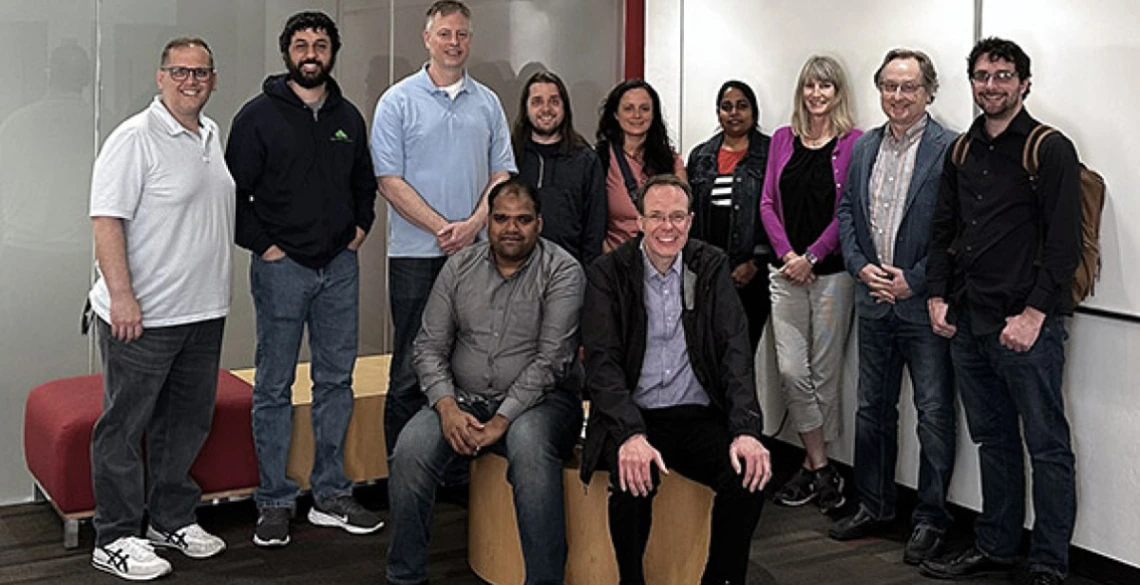Protection for the ‘Internet of Things’ Fueled by Arizona Innovation Has Arrived
Engineering startup launches its second product.

From left to right in back row: Roman Lysecky, RJ Fendricks, Gary Gill, Adam Schafer, Nisrine Jorio, Kanimozhi Thangappan, Kallee Noel, Jerzy Rozenblit, Jonathon Reach. Front row: Santhosh Raghavan, Colin Duggan
University of Arizona startup BG Networks has announced the release of the company’s AnCyRTM (Anomaly Detection and Cyber Resilience) host-based software anomaly detection technology. The system was originally invented by a team from the College of Engineering led by professor emeritus of electrical and computer engineering Roman Lysecky and distinguished professor of electrical and computer engineering Jerzy Rozenblit. Other inventors on the project included former graduate student researcher Nadir Carreon and Johannes Sametinger, a professor at Joannes Kepler University Linz in Austria.
“The launch of AnCyR is the realization of our vision to ensure attacks on life-critical systems, such as automobiles or medical devices, are detected and mitigated fast enough to prevent the worst-case outcome,” said Rozenblit.
The team worked with Tech Launch Arizona, the UA office that commercializes inventions stemming from university research and innovation, to protect the intellectual property for the invention and develop strategies and skills to position the startup for its successful launch. The university licensed the invention to the company to take it forward into the marketplace in 2020.
“This is an exciting moment for the company and for the University of Arizona,” said TLA Associate Vice President Doug Hockstad. “To see BG Networks launch its second product is a testament to the strength of the company and the quality of the product’s foundational innovation. We’re proud of this amazing team of inventor-entrepreneurs.”
The startup’s first product, BGN-SAT, was launched in the spring of 2022. BGN-SAT is a security automation tool designed to help engineers improve security, reduce development time, and take advantage of the existing security features embedded in devices and systems.
Cars on the road today contain a network of automotive electronic control units (or ECUs); this translates to between 70 and 100 in every vehicle, all networked together to control everything from climate to entertainment to acceleration to braking. These functions are complex, requiring approximately 100 million lines of code. And because cars are now networked and connected to the internet, they are vulnerable to cyberattacks. AnCyR is the first anomaly detection software optimized for ECU intrusion detection and protection (IDPS) cybersecurity. Based on five years of university research with support from the National Science Foundation, AnCyR combines statistical, probabilistic, and machine learning algorithms to accurately detect attacks with best-in-class false positives, latency and overhead. According to Lysecky and Rozenblit, AnCyR is the only solution with the high performance and low overhead needed to be the front line of monitoring and defense for automotive ECUs.
“Intrusion and anomaly detection is required to effectively protect the connected car from cyber criminals. No solution is complete without the ability to monitor ECUs for a range of attacks including zero-days,” says Lysecky, who is also the CTO of BG Networks. “AnCyR will provide this critical front line of defense that allows automotive OEMs and Tier 1 manufacturers to instantly respond to cyber-attacks.”
“Zero-days” refers to attacks that exploit previously unforeseen vulnerabilities. The term derives from the idea that vendors and developers have no idea that a flaw exists until it is exploited, thus leaving them “zero days” to fix it.
BG Networks has also announced the receipt of seed funding totaling $4.5 million led by Boston Seed Capital. These funds will be used to launch AnCyR and to expand the company’s growth in cybersecurity automation software and services. The company also announced that Ray Stata, a founder of Analog Devices, has joined the company’s investors including Gutbrain Ventures, PBJ Capital, Permit Ventures, Joint Effects, and Sand Hill Angels.
The Bigger Picture of Internet of Things
While BG Networks initially focused its first product on automobiles, the university startup was formed around a much bigger idea that remains a driving force for the leadership team. Ultimately, their aim is to provide security and tools that will allow engineers to implement strong cybersecurity strategies such as encryption, authentication, and secure software updates quickly and easily for all kinds of systems.
Those systems are ubiquitous in today’s world. From the sensors in our cars to the smart speakers in our homes to the computers on our desks (and in our pockets and on our wrists), the Internet of Things is made up of all these interconnected devices. Aside from the devices that we think about as being part of our daily lives, industry and society are also dependent upon networked technologies for everything from managing oil pipelines to water supplies to electrical grids. These networks represent prime targets for cyberattacks.
BG Networks provides embedded engineers with easy-to-use software automation tools and services to quickly implement cybersecurity tailored to their devices. Based on NIST recommendations and automotive regulations such as ISO/SAE 21434 and UN R155, BG Networks’ solutions provide confidence that cybersecurity has been implemented correctly. Supporting engineers in the automotive, military, medical, and industrial markets, BG Networks is the first company focused on IoT security automation.
Educating the Next Generation of Cybersecurity Experts
The BG Networks team arose out of the academic excellence housed in the Department of Electrical and Computer Engineering. While cybersecurity is one of many areas of focus for the department, the university is leading the way on multiple fronts. Most recently, the university launched a degree program whereby students can get a Bachelor of Applied Science in Cyber Operations. The National Security Agency has designated the program as a Center of Academic Excellence in Cyber Operations (CAE-CO), meeting the most demanding academic and technical requirements.
“With the growing importance of cyber security and the university’s focus on advancing the field, we expect to see continued growth in the flow of incredible, well-prepared professionals along with impactful technical innovations from the university, all moving out into the world for the public good,” said Hockstad.



